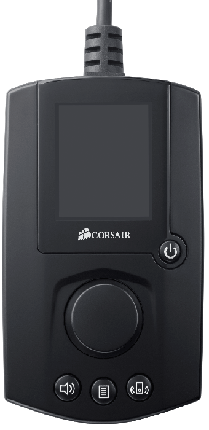Sartorial elegance
Corsair has been blazing a trail of late. Known to many as a manufacturer of a wide range of system memory, the company has been busy diversifying into a number of related markets: we've seen high-quality chassis, coolers and a gaming headset launched in the last two years. With a solid start under its belt, Corsair has returned with the SP2500 - its first attempt at a set of high-end 2.1 speakers. At £190, they certainly aren’t cheap, but we examine if the manufacturer done enough to justify the price.
The Behemoth
The first thing you’re likely to notice about the SP2500s is the monumental subwoofer, measuring in at 46cm x 25.8cm x 29.7cm. Built from MDF and housing an 8in driver rated at 120W RMS, the sub is suitably huge and takes up the majority of the box that the speakers ship in. It’s well-built, though, with a reassuring heft and a finish that feels suitably upper tier.
Bigger isn't always necessarily better, but the design of the sub, using what's known as a 4th order-band-pass subwoofer, means that it needs to be large in order to produce a deep, rich, distortion-free bass that's conspicuously lacking in cheaper models.
All of the connections - for power, the speakers and the remote - are housed at the back on metal plates. This gives the box a clean, understated look, and even though you aren’t likely to have it on display, you’d feel no shame if it was visible.
Satellite Anthem Icarus
The two plastic-bodied satellite speakers are bi-amplified and feature two drivers. Rated at 56W each, they are smaller than the sub, obviously, but still have a reassuring heft to them. From an aesthetic standpoint, we'd prefer a wooden or metal finish, but the SP2500s neither look nor feel cheap; the fit and finish is top-notch. Toeing-in the satellites promotes an accurate stereo image - a sweetspot, if you will - according to Corsair, and the philosophy fits in with two-speaker hi-fi setups.
Corsair, then, rates the total package at an ear-bashing 232W RMS. One man's RMS may not necessarily equate with another's, and Corsair's method is line with the standard described by the Federal Trade Commission (rule 39 FR 15387), which requires accurate power with low distortion. What's more, delving into the specifications reveals that the SP2500s are rated to run at maximum volume for two days: just don't tell the neighbours beforehand!
The remote, which features a full-colour display, also has a nice feel. The buttons are solid and responsive, and the navigation wheel provides a slight click as it’s turned, giving it a nice bit of weight. The display definitely puts the cool into the SP2500s, providing a clean, clear and informative method of navigating through a range of menus and options.

In all, the speakers are solidly built and definitely look the part. They may not have the most stylish or futuristic design on the market, but they have a simple and inoffensive aesthetic that would look great next to a big gaming monitor.
Setup
Once the SP2500s are out of box, getting them hooked up is pretty trivial. The sub has a phono and a 3.5mm input on the back, and the remote has a second 3.5mm jack for hooking up an MP3 player, phone, or whatever else you might have. Conveniently, the manufacturer ships the speakers with male-to-male 3.5mm and phono cables, in case you don’t have your own, making set-up a cinch.
Plug me in
Building on its experience of building PSUs, Corsair saw a lot of similarities between the ideal speaker cable and the optimum power connector. The result is that the SP2500s use four-pin ATX12V power cables to connect each satellite to the sub. There are apparently a lot of positives to this; the main ones being the power characteristics of the cables and the simplicity of the plug.
The use of bi-amped speakers for the subs would necessitate four wires (+ and – for each driver) for each one of the left and right channels. The ATX cables mean that a single plug can be used, and the keyed design guarantees that the right wire goes to the right place.
In use
When you're ready to go, most of the time will be spent interacting with the remote control, which also handles all of the equalizer settings. The colour screen is flanked by the power button, while buttons for speaker volume, the main menu and the sub volume sit just underneath. The second 3.5mm input and the USB input sit on the front and back edges, respectively.
As well as a number of equalizer settings, the remote can be used to activate environmental modes which make use of the digital crossover and apply various effects to the audio. The most interesting are the Mod X, Headphone, Action Gaming and FPS EQ settings and the Late Night environmental mode. The latter diverts the low-end bass to the satellites in order to keep the rumble to a minimum, but also applies dynamic-range compression, preventing any sudden volume changes. Mod X works by reducing the high-end, compensating for the boost typical of movie soundtracks and making film audio sound better in a smaller environment.





